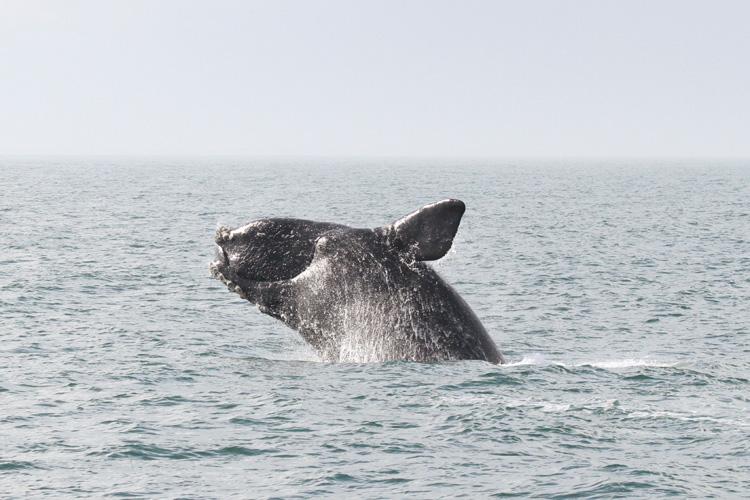
Alarming new estimate of North Atlantic right whale population
A new estimate from the North Atlantic Right Whale Consortium finds that the critically endangered North Atlantic right whale population remains at risk of extinction with only around 356 whales in 2022.
In 2021, their population estimate was around 340 North Atlantic right whales, but was recalculated to 364, primarily due to the recent cataloging of 18 calves born in 2021. Oceana is urgently calling on the National Oceanic and Atmospheric Administration (NOAA), Fisheries and Oceans Canada, and Transport Canada to increase protections to save these whales from extinction.

A right whale breaches. Credit: NOAA Fisheries
In response to the announcement, Oceana released the following statements:
“Each year, it’s unfortunately the same story: North Atlantic right whales are swimming along the cliff of extinction. We know what is killing these whales, and yet long-term solutions like stronger vessel speed rules are continually delayed. NOAA’s job is to prevent the extinction of critically endangered animals like North Atlantic right whales, yet this species is still not on a path to recovery and desperately needs stronger safeguards from ship strikes and fishing gear entanglements. We cannot let political showboating, congressional roadblocks, and finger-pointing delay needed protections for North Atlantic right whales. NOAA must establish real protections for these whales before they swim off the cliff of extinction forever,” says Gib Brogan, campaign director at Oceana in the United States.
Kim Elmslie, campaign director at Oceana in Canada, says: “With only around 356 North Atlantic right whales remaining, this species is at risk of disappearing forever. They are coping with a changing climate and the ever-present threats of entanglement in fishing gear and vessel strikes. Transitioning to ropeless fishing gear is the best way to reduce the risk of entanglement and demonstrate the strong government action required under the US Marine Mammal Protection Act in order to protect access for Canadian commercial fisheries to the lucrative US market. Our governments can still save this fragile population from extinction, particularly if it invests in long-term funding for science, monitoring and enforcing protection measures.”
Last week, Oceana released a report that showed most boats are speeding through slow zones designed to protect critically endangered North Atlantic right whales. Oceana analysed boat speeds from November 2020 through July 2022 in slow zones established by NOAA along the US East Coast and found that 84 per cent of boats sped through mandatory slow zones, and 82% of boats sped through voluntary slow zones. This report shows that stronger safeguards and increased enforcement are needed to save North Atlantic right whales.
At risk: North Atlantic right whales
North Atlantic right whales were named for being the “right” whale to hunt because they were often found near shore, swim slowly, and tend to float when killed. They were aggressively hunted, and their population dropped from peak estimates of up to 21,000 to perhaps fewer than 100 by the 1920s. After whaling of North Atlantic right whales was banned in 1935, their population increased to as many as 483 individuals in 2010. Unfortunately, that progress has reversed.
Collisions with boats is a leading cause of North Atlantic right whale injury and death. They are slow, swimming around 6 miles (or 9.5 kilometres) per hour, usually near the water’s surface. They are also dark in color and lack a dorsal fin, making them very difficult to spot. Studies have found that the speed of a vessel is a major factor in vessel-related collisions with North Atlantic right whales. At high speeds, vessels cannot maneuver to avoid them, and they swim too slowly to be able to move out of the way. This puts them at great risk of being struck, which can cause deadly injuries from blunt-force trauma or cuts from propellers.
Entanglements in fishing gear used to catch lobster, crab, and other species is another leading cause of North Atlantic right whale deaths. Around one-quarter of the population is entangled in fishing gear from the U.S. and Canada each year, and about 85% have been entangled at least once. Ropes have been seen wrapped around their mouths, fins, tails, and bodies, which slow them down; make it difficult to swim, reproduce, and feed; and can cause death. The lines cut into the whales’ flesh, leading to life-threatening infections, and are so strong that they have severed fins and tails, and cut into bone.
The new estimate from the North Atlantic Right Whale Consortium was released this week (23 October 2023).
Oceana is the largest international advocacy organisation dedicated solely to ocean conservation.
Oceana Canada was established as an independent charity in 2015.
The post Alarming new estimate of North Atlantic right whale population appeared first on Marine Industry News.
